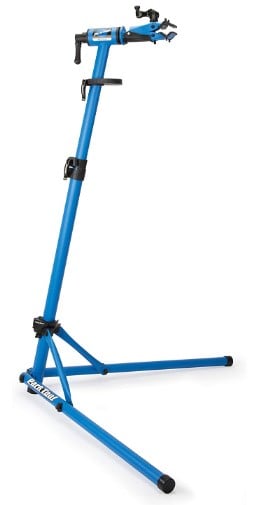Every DIY bike mechanic understands the role of a bike repair stand. Sadly, most are put off by their high price, and it compels them to ask, ‘why are bike repair stands so expensive?’
Bike repair stands are expensive because so much money goes into their manufacturing, design, and certification. The manufacturer and, by extension, the retailer pass the cost to the consumer.
We’ll look at how much you can spend on a stand, budget options, and other alternatives. Moreover, we’ll look at how a bike repair stand makes sense to you and why you should get one.
But before that, let’s explain our title question more.

Why Are Bike Repair Stands So Expensive?
Bike repair stands are primarily expensive because of the high cost of production. Manufacturers invest a lot of money in raw materials, design, and even certification to guarantee quality work stands.
And since they have to get their money back and make some profit, they pass the financial burden to the consumer.
Retailers don’t help either. They also add their profits to what they pay or are expected to pay the manufacturer, making bike pair stands more expensive.
Don’t forget the shipping too, as it’s sometimes as expensive as the bike repair stand. The longer you are from the seller, the costlier the shipping and the overall cost of procuring a bike repair stand.
So, How Expensive Are Bike Repair Stands?
Overall, a decent bike repair stand averages $200 or more, with some high-end options costing as much as $500.
For the average biker, spending $200 plus looks like a lot of money, especially when you are not sure about the value you’ll be getting.
Note, however, that the costliest bike repair stands usually promise something extra. It could be an adjustable height, massive carry capacity, quick-release, magnetic tool tray, 360-degree adjustment, to name a few.
That’s what a bike repair stand like the Park Tool PCS-10.2 (View on Amazon) promises. Its 80-pound capacity is desirable, making it ideal for the heaviest bikes.
And with the repair stand collapsing quickly, its portability is unquestionable. So, you may end up not complaining about paying slightly more than $200 for it.

What If You Are On A Budget? Can You Get a Bike Repair Stand for Cheap?
Being on a budget doesn’t mean that you cannot get a bike repair stand. The issue is that it won’t be easy finding it, and you may have to make a few compromises.
For one, you may have to compromise on the weight capacity.
For example, a bike repair stand like the Bikehand Bike Repair Stand cost under $150 and is generally a decent option.
You, however, have to settle for a 55-pound weight limit.
Overall, the repair stand promises remarkable features like adjustable height, 360-degree rotation, quick-release, portable design, durable built, and magnetic tool plate.
Another budget option is the CXWXC Bike Repair Stand (View on Amazon), which costs slightly under $90 and comes with a 60-pound carry capacity.
The repair stand is equally strong, firm, adjustable, and user-friendly.
So, generally, you can get a decent budget bike repair stand with $80-$150.
Is a Bike Repair Stand Worth It?
If you are planning to do any of the jobs on the list below, a bike repair stand is worth it:
- Bike repairs
- Handlebar replacement
- Wheel alignment
- Bike cleaning and greasing
- Gear lever adjustment
- Brake pad replacement
- Brake adjustment
Generally, bike repair stands are effective in performing the above because of these reasons:
- They hold the bike firmly to allow you to work freely
- They are super strong to hold massive bike weight
- Allow you 360-degree access to the cycle for easy repairs and maintenance
- Most of them are portable to allow you to fix your bike anywhere

Are There Cheaper Alternatives to Bike Repair Stands?
We’ve seen that you need at least $80 to get a decent bike repair stand, but what if you don’t have $80? What if what you can spare is $50 or less?
If so, then you should consider getting:
a) A bike floor stand
A bike parking floor rack like the Bikehand Bicycle Floor Rack costs under $50. Even though it’s a parking stand, the fact that it is freestanding means you can place your bike there and fix it.
Note, however, that you won’t have 360-degree access or be able to adjust the bike height as you do on a bike repair stand.
But still, you can do a lot of repairs and maintenances. The bonus is that you can park your bike there, and it can hold three cycles.
b) A wall bike mount
Alternatively, you can get a wall bike mount, which is even cheaper than a floor bike parking stand. But unlike a parking stand, a wall mount rack is not portable.
You’ll also only have 90-degree access to your bike instead of 360-degrees, which you get from a bike repair stand.
But if you are tight on a budget and want someplace to mount your bike, a wall rack makes sense.

What If You Don’t Have Money? What Are Your Options?
Let me start by affirming that a bike repair stand is irreplaceable. A bike repair stand is more robust, adjustable, and convenient for bike repairs, servicing, and maintenances.
But if you don’t have money to get a bike repair stand or a floor parking stand, consider these options.
Suspend the Bicycle
Though suspending your bike with a rope is not the firmest way to hang your bike, it allows you to access your bike from all angles.
The rope and support must be stronger to ensure the bike doesn’t drop. If the bicycle falls, then you’ll end up with a costlier repair than the original.
And since the rope is not firm, the bike will be shaky, forcing you to hold it when working.
You can, however, slightly reduce the shakiness by tying the bike on the frame, seat tube, and head tube.
Turn it Upside Down
If the project involves the wheel or drivetrain, in particular, then you don’t have to mount the bike on the stand.
In such a case, you can turn your bike upside down. Make sure, however, that you protect the handlebar and saddle by resting the bike on a soft surface.
Make a DIY Bike Stand
Here are your options:
- PVC repair stand – If you can get thick PVC pipes, you can use them to make a DIY bike repair stand. You’ll need to make a stable base and erect some strong PVC poles and a hook for your bike.
- Wooden bench stand – This is probably the most straightforward DIY project for a bike repair stand. You only need a working bench and some PVC pipes to mount your bike.
FAQs on Expensive Bike Repair Stands
1. What Is The Best Bicycle Repair Stand?
By considering the carrying capacity, ease of use, height adjustability, and angle rotation, here are the best bike repair stands:
- Bikehand E-Bike Repair Stand – Holds up to 110 pound
- Park Tool PCS-10.2 – Hold up to 80 pounds
- CXWXC Bike Repair Stand – Hold up to 60 pounds
- Bikehand Bike Repair Stand – Hold up to 55 pounds
2. Can I Store My Bike On A Repair Stand?
You can mount a bike on a repair stand and store it there for a couple of hours. So, a repair stand is only a temporary storage option.
If you clamp your bike for long, you could damage the seat tube or crossbar, and you wouldn’t want that.
3. What Should I Look For In A Bicycle Repair Stand?
Here are the things to look for in a bike repair stand:
- An option that can tolerate the weight of your bike
- A bike stand with an adjustable height
- An option that offers you 360-degree bike rotation
- Ease of use
- Durable build
- Portable option
4. How Much Is A Bike Repair Stand?
On average, you can get a decent budget bike repair stand for $800-$150. But if you want more carrying capacity and user flexibility, you may have to spare $200-$500, depending on the bike repair stand brand.
5. Who Makes The Best Bicycle Repair Stand?
While there are many bike repair stand manufacturers, not all make quality and tested products.
Based on customer reviews, here are the best bicycle repair brands:
- Bikehand
- Park Tool
- CXWXC
6. Is It Bad To Leave A Bike On A Stand?
It’s not an issue leaving a bike on a stand as long as you don’t do it for a long time. If you do, the clamp may weaken the seat tube or crossbar, affecting your bike’s overall integrity and durability.
Also, if you have to leave your bike on a stand for a couple of hours, you shouldn’t leave it in the rain. Rain is likely to attract rust, which attacks the bike frame.
Also Read: Best Bike Racks for Honda CRV
To sum things up, why are bike repair stands so expensive?
Understandably, bike repair stands are costlier because the manufacturers use so much money to make them and pass the financial burden to the end-user.
Nevertheless, the good news is that there are a few decent budget options on the market like the ones I’ve shared.
Frequently Asked Questions
Is a bike repair stand really necessary?
A bike repair stand isn’t seen as a must-have for every cyclist, especially for those just engaging in rudimentary maintenance tasks such as tire swaps or chain lubrication. However, it quickly becomes indispensable once you dive into more intricate tasks like fine-tuning derailleurs or tinkering with cables. The pivotal advantage of a bike repair stand is that it suspends your bike off the ground, allowing you easier and more comfortable access to components otherwise tough to reach. In my experience, there is always a turning point in every cyclist’s journey where a repair stand goes from a “nice-to-have” to a “can’t live without”. And once that shift happens, you’ll likely never look back, as the ease of use and convenience are hard to deny.
Why are bike racks surprisingly expensive?
You might initially experience sticker shock when looking at the price tags of bike racks, but believe me, it’s not a greedy mark-up or a scam. The seemingly steep prices are primarily down to economic reasons. First, let’s consider the cost of manufacturing a solid, durable bike rack – it’s not as economical as you might think. Next is the relatively low sales volume for each specific rack model, which means less opportunity to spread out these costs. On top of that, suppliers have to cover their investments in research and development to ensure safety standards, innovate new features, and guarantee a long product lifespan. As a long-term user of bike racks, I can attest that you don’t want to skimp on quality. They don’t just hold your bike – they protect your valuable investment while you’re out on the road.
What’s the purpose of a bike stand?
In the cycling world, a “bike stand” can refer to two different products, each serving a unique purpose. One type of bike stand is essentially a storage solution that keeps your bike upright and stable when not in use. It’s a simple but effective way to prevent your bike from toppling over and causing unnecessary damage. The other type of bike stand, often referred to as a bike repair stand, is designed to elevate your bike off the ground to facilitate easy access to all parts and components for maintenance and repair work. Picture an auto mechanic’s lift, but for a bike! My bike stands have saved me countless hours in repair time, not to mention the rubber band trick I used to use to keep my bike balanced for cleaning and adjusting.
Could leaving a bike in a repair stand be harmful?
You may be wary of leaving your bike hoisted in a repair stand for lengthy periods, thinking this might strain or damage key components, but you can generally put these worries to rest. In fact, the pressure exerted on stationary parts when a bike is aloft in a stand is very different from the dynamic forces they face while being ridden. This static force doesn’t pose any risk of damaging your ride. I’ve often left my bike in its stand for weeks while performing overhauls or waiting for parts to come in, with no adverse effects to report. It’s also worth noting that, if you won’t be riding your bike for a while, suspending it in a stand could even be a better storage solution than leaving it standing on its own tires, which could lead to flat spots or changes in tyre pressures.
